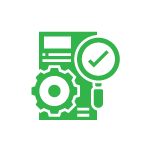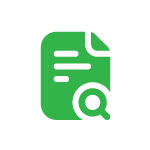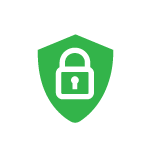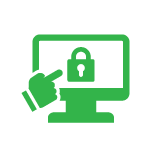What pharma regulatory compliance software validation & security standards are needed to ensure a safe, secure print and sample management platform?
As an IT department for pharma, part of your role is to ensure the platforms utilized by your organization meet your client’s functional needs and provide the security needed to ensure your data is safe and protected.
In specific markets, such as healthcare and life sciences, patient health and information cannot be leaked and must be managed using standard SOPs and systems. Therefore, we’ve assembled a guide to what to look for in these platforms, related items to consider, and how you can assure compliance with internal and external requirements.
What is software validation and testing, and what process should be followed?
Software validation and testing is the process of verifying that software meets specified requirements and is fit for its intended purpose. It is a critical step in the software development process, as it helps to ensure that the software is reliable, efficient, and effective.
It typically involves a series of steps, including defining the validation plan, performing testing, reviewing test results, and documenting the validation process. Various types of testing may be performed, including functional testing, performance testing, and usability testing, among others.
Effective software validation and testing are essential to the success of any software project, as it helps to ensure that the software meets the needs of its users and performs as intended. It is also important to ensure that the software is of high quality, as this can help to reduce the risk of issues or defects that could impact the user experience or the overall performance of the software.
What is included in SDLC software validation?
Software development life cycle (SDLC) validation is the process of verifying that software meets specified requirements and is fit for its intended purpose. SDLC validation is typically carried out during the testing phase of the software development process.
There are several steps involved in SDLC validation, including:

Define the validation plan:
The first step in SDLC validation is to define the scope of the validation and the acceptance criteria the software must meet. This typically includes specifying the software’s requirements and the tests that will be used to verify that it meets these requirements.

Perform testing:
The next step in SDLC validation is testing to verify that the software meets the specified requirements. This may include functional testing, performance testing, and usability testing, among others.

Review test results:
Once testing is complete, the results of the tests are reviewed to determine whether the software meets the acceptance criteria. If any issues are identified, they are addressed, and the software is retested until it meets the specified requirements.

Document the validation process:
The final step in SDLC validation is to document the validation process and the results of the tests. This documentation demonstrates that the software has been thoroughly tested and meets the specified requirements.
Overall, SDLC validation is an essential step in the software development process, as it helps to ensure that the software is fit for its intended purpose and meets the needs of its users.
What is the NIST Cybersecurity Framework?
The National Institute of Standards and Technology (NIST) Cybersecurity Framework (CSF) is a set of guidelines and best practices for managing cybersecurity risk. It is intended to help organizations of all sizes and sectors assess their cybersecurity risk, develop and implement cybersecurity controls, and improve their overall cybersecurity posture.
The NIST CSF is flexible and scalable by design so that organizations can customize it to fit their specific needs and risk profile. It is organized into five core functions: Identity, Protect, Detect, Respond, and Recover. These functions are further broken down into categories and subcategories that provide more detailed guidance on specific cybersecurity activities.
The NIST CSF is not mandatory, but organizations widely adopt it as a best practice framework for managing cybersecurity risk. It is regularly updated to reflect the evolving threat landscape and to provide guidance on the latest cybersecurity technologies and practices.
Overall, the NIST Cybersecurity Framework is a valuable resource for organizations looking to improve their cybersecurity posture and manage risk comprehensively and effectively.
What are some of the privacy laws you'll need to comply with? Ex HITECH/GLBA, E.U. GDPR, and Canada PIPEDA privacy laws
Several national and international laws are in place that establishes privacy and security standards for handling personal information and gives individuals certain rights concerning their data. A few of them to keep in mind include the following:
- HITECH/GLBA: The Health Insurance Portability and Accountability Act (HIPAA) is a US federal law establishing standards for protecting personal health information. The Health Information Technology for Economic and Clinical Health Act (HITECH) is an amendment to HIPAA that expands its scope to include electronic health records (EHRs) and other health information technology. The Gramm-Leach-Bliley Act (GLBA) is a US federal law that requires financial institutions to protect the privacy of customer information. Together, HIPAA/HITECH and GLBA establish privacy and security standards for handling personal health and financial information.
- U. GDPR: The General Data Protection Regulation (GDPR) is a European Union (EU) regulation establishing standards for protecting personal data. It applies to organizations that process the personal data of individuals in the EU, regardless of the organization’s location. The GDPR requires organizations to be transparent about collecting, using, and sharing personal data. It gives individuals the right to access, rectify, erase, and restrict the processing of personal data.
- Canada PIPEDA: The Personal Information Protection and Electronic Documents Act (PIPEDA) is a Canadian federal privacy law that applies to organizations that collect, use, or disclose personal information during commercial activities. PIPEDA establishes the principles that organizations must follow when collecting, using, and disclosing personal information and gives people the right to access and request correction of their
personal data.
What to know about 21 CFR (Part 11) compliant data capture
21 CFR Part 11 is a set of regulations issued by the US Food and Drug Administration (FDA) that pertain to electronic records and electronic signatures. Part 11 sets forth the requirements for electronic records and electronic signatures that are intended to be equivalent to paper records and handwritten signatures.
21 CFR Part 11 compliant data capture refers to collecting, storing, and accessing electronic data in a manner that meets the requirements of Part 11. Some key provisions of Part 11 for data capture include the following:
- Validation of systems: Part 11 requires that systems used for data capture be validated to ensure their reliability, accuracy, and consistent intended performance.
- Electronic records and signatures: Part 11 requires that electronic records and signatures be used in place of paper records and handwritten signatures, where appropriate. Electronic records and signatures must be trustworthy, reliable, and readily available for inspection and review.
- Security measures: Part 11 requires appropriate security measures to protect electronic records and signatures from unauthorized access, alteration, or deletion.
- Auditing and documentation: Part 11 requires that electronic records and signatures be accompanied by appropriate documentation, and that systems be audited to ensure compliance with Part 11 requirements.
Overall, 21 CFR Part 11 compliant data capture is an important aspect of the pharmaceutical industry, as it helps to ensure the integrity and reliability of electronic data used in the development, testing, and marketing of pharmaceutical products.
Are you concerned about the PAAB Compliant (Pharmaceutical Advertising Advisory Board)?
The PAAB is a self-regulatory body that is responsible for reviewing and approving the advertising and promotional materials of prescription drugs and medical devices in Canada. It is governed by a board of directors that includes representatives from the pharmaceutical industry, healthcare professionals, and the public.
The PAAB’s mandate is to ensure that pharmaceutical advertising and promotional materials are accurate, balanced, and compliant with relevant laws and guidelines. It reviews materials submitted by pharmaceutical companies and provides feedback to ensure that they meet these standards.
The PAAB plays an important role in regulating pharmaceutical advertising in Canada and helping to ensure that it is accurate and balanced. This helps to protect the interests of both healthcare professionals and patients and supports the safe and effective use of prescription drugs and medical devices.
Lastly, ensure proper system setup with a dedicated data environment and private sub-domain registry
A dedicated data environment is a separate, secure area within a computer system or network reserved for a specific purpose or group of users. A dedicated data environment may be used for various purposes, including data storage, processing, and analysis.
A private sub-domain registry is a system that is used to manage and assign sub-domains within a domain. Sub-domains are sub-sections of a domain to organize and categorize content within a website or network. A private sub-domain registry enables an organization to manage its sub-domains in a centralized and secure manner.
Together, a dedicated data environment and a private sub-domain registry can be used to create a secure and organized environment for storing and accessing data within a computer system or network. This can help protect the data’s confidentiality and integrity and ensure that it is only accessed by authorized users
What are the typical elements of used in a secure portal for drug sample recall?
A secure portal for managing drug sample recall is a web-based platform that is designed to facilitate the recall process for pharmaceutical products. The portal should be designed to ensure the confidentiality and security of sensitive information related to the recall.
Some features that a secure portal for managing drug sample recall might include are:

Login and authentication:
The portal should require users to login and authenticate their identity before accessing the platform. This can help ensure that only authorized users have access to the portal and its sensitive information.

Encryption:
The portal should use encryption to protect the confidentiality of the information transmitted through it. This can help to prevent unauthorized access to the information.

Access controls:
The portal should require users to login and authenticate their identity before accessing the platform. This can help ensure that only authorized users have access to the portal and its sensitive information.

Auditing and reporting:
The portal should include auditing and reporting capabilities to track user activity and identify any potential security breaches.
Overall, a secure portal for managing drug sample recalls can help to ensure the confidentiality and security of the information related to the recall process while also enabling the efficient management of the recall.
What is the Circulo Pharma Systems approach to managing drug sample recalls and drug-related marketing materials?
The Circulo Pharma Platform empowers the sales organization of drug manufacturers by developing and providing tools to enhance the management, distribution, and production of marketing documentation, product monographs, and drug samples in compliance with all pharmaceutical regulations. The platform provides:
- 24/7 access to order entry & tracking
- Validated to the latest standards
- Multi-level user access
- Easy-to-use user interface
- Integrates with existing order and distribution tracking platforms
- CRM integration
- Customizable reporting of inventory and rep activity
The Circulo management platform offers everything you need in one single, secure package that includes documented SOPs and testing criteria for:
- SDLC Validation
- Modeled to meet NIST Cybersecurity Framework
- Meets national and international privacy laws
- 21 CFR (Part 11) compliant data capture
- Enhanced Business Continuity Disaster Recovery (BCDR)
- PAAB Compliant (Pharmaceutical Advertising Advisory Board)
- Dedicated data environment and private sub-domain registry
Working with Circulo Pharma Enables the Following Benefits

Assure Compliance with Regulatory Organizations
Protect your organization from potentially serious repercussions. Streamline regulatory processes, improve data quality, and allow your business to respond faster with sample accountability, field auditing and inventory, returns processing, reporting, and analytics.

Focus on Improved Customer Experiences
Make every patient and doctor touchpoint a positive experience by providing them with the medical education and promotional materials they need to encourage trustworthiness, relevance, and simplicity in their reps.

Provides Complete Visibility into the Distribution and Recall Process
We also offer full visibility into the process with thorough tracking and reporting for all projects, from project planning to final delivery. For those looking for an on-demand solution for print and sample distribution and recall, the Circulo Management portal is available.
For more information on how Circulo Pharma can help you reduce your costs, reduce risk and increase your team’s efficiency contact us today.
